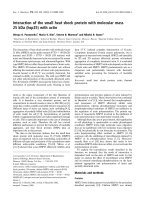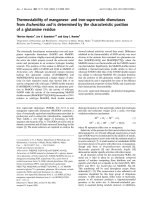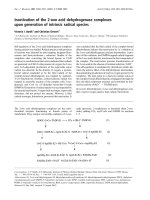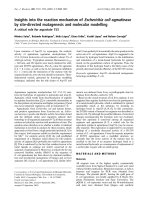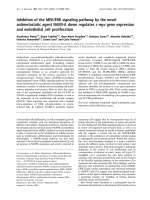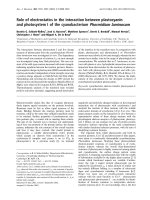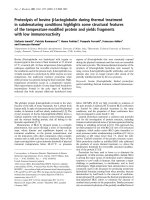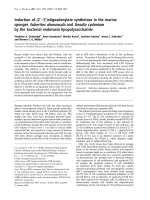Báo cáo Y học: Interaction of the GTS1 gene product with glyceraldehyde3-phosphate dehydrogenase 1 required for the maintenance of the metabolic oscillations of the yeast Saccharomyces cerevisiae pdf
Bạn đang xem bản rút gọn của tài liệu. Xem và tải ngay bản đầy đủ của tài liệu tại đây (456.32 KB, 10 trang )
Interaction of the
GTS1
gene product with glyceraldehyde-
3-phosphate dehydrogenase 1 required for the maintenance
of the metabolic oscillations of the yeast
Saccharomyces cerevisiae
Weidong Liu, Jinqing Wang, Kazuhiro Mitsui, Hua Shen and Kunio Tsurugi
Department of Biochemistry, Yamanashi Medical University, Japan
We previously reported that GTS1 is involved in regulating
ultradian oscillations of the glycolytic pathway induced by
cyanide in cell suspensions as well as oscillations of energy
metabolism in aerobic continuous cultures. Here, we
screened a yeast cDNA library for proteins that bind to
Gts1p using the yeast two-hybrid system and cloned multiple
TDH cDNAs encoding the glycolytic enzyme glyceralde-
hyde-3-phosphate dehydrogenase (GAPDH). We found
that the zinc-finger and dimerization sites of Gts1p were
required for full ability to bind GAPDH, and Gts1ps
mutated at these sites lost the ability to regulate both aerobic
and unaerobic ultradian oscillations of energy metabolism.
Of the three TDH genes, only TDH1 fluctuated at the
mRNA level in continuous culture and its deletion resulted
in the disappearance of the oscillation without any affect on
growth rate. This loss of biological rhythms in the TDH1-
deleted mutant was rescued by the expression of TDH1 but
not of TDH2 or TDH3 under the control of the TDH1
promoter. Thus, we hypothesized that Gts1p plays a role in
the regulation of metabolic oscillation by interacting with the
TDH1 product, GAPDH1, in yeast.
Keywords: continuous culture; glyceraldehyde-3-phosphate
dehydrogenase; Gts1p; metabolic oscillation; yeast.
Ultradian (cycles with a period shorter than 24 h) oscilla-
tions of the glycolytic pathway were induced after addition
of glucose by inhibiting mitochondrial respiration with
cyanide in cell suspensions [1–3] or cell extracts [4] of yeast
with a periodicity of 1–2 min as monitored by measuring
the level of NAD(P)H (reviewed in [5]). The glycolytic
pathway has been shown to be an autogenous oscillator
under extreme nonequilibrium conditions of energy in
dissipative structures, which theoretically include all living
organisms [5–7]. The pathway oscillates under the primary
control of phosphofructokinase [8,9], transferring energy
from glucose to NADH, which acts as the feed-forward
activator, and then from NADH to ATP, which acts as the
feedback inhibitor. After ATP as an inhibitor has been
consumed, glucose again begins to enter the glycolytic
pathway. Yeast cells also exhibit sustained ultradian oscil-
lations of energy metabolism, with a periodicity of 4hin
continuous (chemostat) culture under aerobic conditions in
an open system using a bioreactor [10–13]. (Hereafter,
aerobic oscillation will be referred to as energy metabolism
or metabolic oscillation in distinction from cyanide-induced
glycolytic oscillation.) Energy-metabolism oscillations,
which arise spontaneously under conditions of high cell
density ( 5 · 10
8
cellsÆmL
)1
) [14], are detectable as a
periodic change in the factors involved in energy metabo-
lism such as dissolved oxygen (DO) levels, CO
2
production,
glucose and ethanol concentrations, and amounts of storage
carbohydrates [10–13]. DO oscillation is caused by the
periodic change between respiratory and respiratory-fer-
mentative phases, in which oxygen demands are relatively
high and low, respectively. Although the mechanism of
energy-metabolism oscillation has not been elucidated, we
assume that it is similar to that of glycolytic oscillation
except for the involvement of mitochondria in ATP
production as the NAD(P)H level is increased during the
respiratory-fermentative phase [14] and the ATP level is
increased in the early respiratory phase (J. Wang &
K. Tsurugi, unpublished data). The energy-metabolism
oscillation is coupled to oscillations of cell division [12,13,15]
and cellular responses to various stress conditions, such as
heat, oxidative agents and cytotoxic compounds [14,16]. (In
this report, the term ÔcouplingÕ is used to refer to a state in
which multiple oscillators fluctuate with the same periodic-
ity irrespective of phase.) It should be added that a cell-
cycle-independent oscillation of energy metabolism with a
short periodicity (20 min to 1 h) was observed under
particular conditions in continuous cultures [17].
The gene GTS1 was originally isolated from a yeast
cDNA library with oligonucleotides encoding three Gly-Thr
repeats which had been found in the clock-related gene
period [18] and was thus named GTS1 [19]. We subsequently
found that the repeat was translated as an Ala-Gln repeat
in the GTS1 product Gts1p [20], which is similar to the
Gln-rich domain found in the clock-related protein Clock
[21]. Although the structural basis of Gts1p as a clock-
related protein is obscure, mutations of GTS1 showed
pleiotropic effects on yeast in a gene-dosage-dependent
manner; these effects included the timing of budding and
sporulation and the capacity for heat tolerance [19,22], all of
which are known to be clock-related in other organisms
Correspondence to K. Tsurugi, Department of Biochemistry 2,
Yamanashi Medical University, 1110 Shimokato, Tamaho,
Nakakoma, Yamanashi 409-3898, Japan.
Fax: + 55 273 6784, Tel.: + 55 273 6784,
E-mail:
Abbreviations: DO, dissolved oxygen; GAPDH, glyceraldehyde-
3-phosphate dehydrogenase; ABC, ATP-binding cassette.
(Received 4 April 2002, revised 4 June 2002, accepted 12 June 2002)
Eur. J. Biochem. 269, 3560–3569 (2002) Ó FEBS 2002 doi:10.1046/j.1432-1033.2002.03047.x
(reviewed in [23,24]). Further, we found that the amplitudes
and durations of the cyanide-induced ultradian oscillation
changed significantly as a function of the GTS1 gene
dosage, whereas the frequencies of oscillation did not vary
very much among the stains tested [25]. We then reported
that ultradian oscillation of energy metabolism and coup-
ling of oscillations of cell division and stress responses in
continuous culture were disrupted by inactivation of the
GTS1 gene [16]. We recently presented evidence that the
metabolic oscillator drives the heat resistance oscillator
composed of machinery involved in the synthesis of
trehalose [26]. We hypothesized that the synthesis of
trehalose parallels activation of the glycolytic pathway,
and trehalose is degraded by trehalase activated by cAMP
coupled to the metabolic oscillation. Deletion of GTS1
resulted in the loss of the fluctuations in the synthesis of
trehalose and cAMP [26], leading to the disappearance of
the oscillations. These results suggested that Gts1p plays
some role in the coupling of these oscillators. Furthermore,
we suggested that the rhythmic expression of Gts1p is more
important than the protein level for maintenance of
ultradian rhythms, as the constitutive expression of GTS1
under the control of the TPI promoter resulted in the
disappearance of ultradian rhythms [16]. More recently, we
reported that, when GTS1 was expressed under the control
of a short (183-bp) promoter in the GTS1-disrupted mutant,
the amplitude of Gts1p fluctuations was restricted, leading
to attenuation of the metabolic oscillation and the uncoup-
ling of stress-resistance oscillations [27]. Thus, we suggested
that, for stress-resistance oscillations to occur, full fluctu-
ation in the level of Gts1p is required. We are now studying
the molecular mechanism by which Gts1p functions in the
coupling of ultradian oscillations. This study of ultradian
oscillation in yeast should contribute to our understanding
of the biological rhythms in other organisms, as the energy
metabolism pathway is an autogenous oscillator in all living
organisms [5–7], although there may be various modifica-
tions.
Gts1p contains a zinc-finger motif similar to that of
GATA-transcription factors [28] in the N-terminal region
and a glutamine-rich strand in the C-terminal region and
thus Gts1p has been conventionally classified as a tran-
scription factor in the yeast genome database [29]. However,
it is unlikely that Gts1p is a DNA-binding protein because it
binds to neither oligomers containing the GATA motifs nor
Sau3AI fragments derived from the yeast genome in gel
mobility-shift assays (
1
S. Yaguchi & K. Tsurugi, unpublished
data). Now, the zinc finger is shown to be similar to that
contained in GTPase-activating proteins of ADP-ribosyla-
tion factors, which are considered to play a role in protein
interaction rather than DNA binding [30,31]. In addition,
Gts1p has a dimerization site in an 18-amino-acid region of
the C-terminal portion, which plays a role in the formation
of a homodimer and heterodimer with the homologous
cytoplasmic domain of some ATP-binding cassette (ABC)
transporters [32]. The sequence was characterized by a few
acidic amino-acid residues preceded by hydrophobic amino
acids. The presence of these sequences suggested that Gts1p
interacts with various proteins to show pleiotropic effects on
yeast.
In this study of how Gts1p functions, we searched for
proteins that interact with Gts1p using the yeast two-hybrid
system. We found that GAPDH binds to Gts1p and that
both the zinc-finger and the dimerization sites of Gts1p were
involved. We showed that mutations of Gts1p that removed
the zinc finger or dimerization region affected the mainten-
ance of ultradian oscillations of energy metabolism in yeast.
Further, we present evidence that, of the three GAPDH
species in yeast, GAPDH1 is involved in the appearance and
maintenance of metabolic oscillations via interaction with
Gts1p.
MATERIALS AND METHODS
Yeast strains and culture conditions
A haploid strain of the yeast S. cerevisiae,W303,wasused
for cyanide-induced glycolytic oscillation in cell suspensions
[25]. Cells were cultured in medium containing 10 gÆL
)1
glucose, 6.7 gÆL
)1
yeast nitrogen base without amino acids
(Difco Laboratory, Detroit, MI, USA), and 100 m
M
potassium phosphate at pH 5.0 supplemented with
40 lgÆmL
)1
adenine sulfate and essential amino acids. The
cells harvested 1–2 h after the glucose in the medium had
been exhausted [25] were washed and resuspended in
100 m
M
potassium phosphate, pH 6.8, to a concentration
of 4 mg proteinÆmL
)1
before being starved for 3 h at 30 °C.
Oscillations were induced by adding 20 m
M
glucose to the
starvedcellsandthenafter4 min,5m
M
potassium cyanide.
The oscillations were monitored by NADH fluorescence
using a spectrofluorimeter (Hitachi F-4500) in a stirred and
thermostatically regulated cuvette.
Another haploid strain of the yeast S. cerevisiae, S288C,
was used for the continuous cultures [14]. The cells were
cultured at 30 °C in a synthetic medium containing 1%
glucose as defined elsewhere [10] using a modified bench-top
fermenter, MDL-6C (Marubishi Bioengineering, Tokyo,
Japan) with a constant volume of 500 mL. The batch and
successive continuous cultures were performed as described
previously [14,16], and the periodic change in respiratory-
fermentative metabolism was monitored by measuring the
level of DO with an oxygen electrode.
Construction of
GTS1
mutants for the two-hybrid assay
N-Terminal and C-terminal truncated mutants of GTS1
were constructed from the wild-type GTS1 as described
previously [32]. The GTS1 mutant with the KpnI–NcoI
fragment deleted (for a physical map of GTS1, see Fig. 1A),
named GTS1[KN], which corresponds to the dimerization
site covering 18 amino-acid residues from 296 to 313, was
constructed as described previously [32] and named
GTS1[DKN]. To replace the cysteine residue at position
53 in the putative zinc finger with tyrosine, site-directed
mutagenesis was performed according to the protocol of the
kit In vitro Mutagenesis Primers (Takara, Tokyo, Japan)
using primers 1 and 2 (Table 1) as 5¢ primers for the first and
second PCR, respectively. The 2.4-kbp SphI–SpeIfragment
thus obtained containing nucleotides )1572 to +1513, with
respect to the first residue A of GTS1,namedGTS1[C53Y],
was inserted into pAUR112. The mutation was con-
firmed by determining the nucleotide sequence of the
PCR-amplified EcoRI–SalI fragment directed on the
recombinant plasmid. The EcoRI–SalI fragment was inser-
ted into the plasmid (pGBT9) of the two-hybrid system.
GTS1[C53Y] with the dimerization site deleted [32], named
Ó FEBS 2002 Gts1p–GAPDH1 interaction in metabolic oscillations (Eur. J. Biochem. 269) 3561
GTS1{[DKN] + [C53Y]}, was obtained by removing the
KpnI–NcoI fragment from GTS1[C53Y]. GTS1[DC] was
constructed by deleting the ClaI-ClaI fragment from GTS1.
GTS1{[DC] + [DNS]} and GTS1{[DC] + [DKS]} were
obtained by deleting the NcoI–SalIandKpnI–SalI frag-
ments, respectively, from GTS1[DC].
The yeast two-hybrid system
The two-hybrid assay was performed using the Matchma-
ker Two-hybrid System (Clontech) as described previously
[32]. To screen for Gts1p-interacting proteins, a yeast
cDNA library prepared using a cDNA synthesis kit
(Amersham Pharmacia Biotech) was inserted into the
plasmid pGAD424 (LEU2 Amp
r
) downstream of the
activation domain of GAL4. The recombinant plasmids
were transformed together with the recombinant plasmid
pGBT9 (TRP1 Amp
r
) carrying GTS1 in-frame downstream
of the DNA-binding domain of GAL4. To determine the
binding site of Gts1p and GAPDH, the wild-type and
mutant GTS1 genes were inserted into pGBT9, and the
cloned cDNA encoding the C-terminal 97 amino-acid
residues of GAPDH3 (GAPDH3-C97) was inserted into
pGAD424. The interactions between the prey and bait
hybrid proteins were determined as activation of the lacZ
reporter gene by measuring the b-galactosidase activity of
the cells using either or both the colony lift assay and liquid
culture assay for b-galactosidase as described previously
[32]. The protein levels of the Gts1p mutants were examined
by Western blotting using antibody to Gts1p as described
previously [10].
Transformation with a chimeric plasmid harboring
GTS1
The GTS1-deleted mutant gts1D(W303) was produced
using the strain W303 as described previously [22,25]. To
transform gts1D(W303) with GTS1, GTS1[DKN] and
GTS1[C53Y], the constructs were inserted into the vector
pYX222 at the multicloning site. These transformants were
named pYXGTS1/gts1D(W303), pYXGTS1[DKN]/gts1D
(W303) and pYXGTS1[C53Y]/gts1D(W303), respectively.
The GTS1-deleted mutant gts1D was produced using
strain S288C as described previously [14,16]. GTS1[DKN]
and GTS1[C53Y] inserted into pAUR112 were transformed
into gts1D and the transformants were named pACGTS1
[DKN]/gts1D and pACGTS1[C53Y]/gts1D, respectively.
Preparation of
TDH
-deleted mutants
TDH1, TDH2 and TDH3 encoding GAPDH1, GAPDH2
and GAPDH3, respectively [33,34], were cloned by PCR
directed against yeast genomic DNA from S288C. Synthetic
oligonucleotides for 5¢ and 3¢ primers, 3 and 4 for TDH1,
Table 1. List of synthetic oligonucleotides used for primers (1–13) or
probes (14, 15) in this experiment.
No. Sequence (5¢-3¢)
15¢-CCCGAAGCATGCTGTGCCTAC-3¢
25¢-CCCGAAGCATGCTGTGCTCAC-3¢
35¢-GGAGAATTCGTTGGGCTGAGCTTCTGATCC-3¢
45¢-TTGGGATCCTTAAGCCTTGGCAACATATTC-3¢
55¢-CTTTGAATTCTGCTGTAACCCGTACATGCC-3¢
65¢-ATTAGAATTCGCGGCTAAAGTTAAGCATGC-3¢
75¢-GAAAACTGGATCCGACTTGTATGCTAAAGG-3¢
85¢-TTGGGATCCTTAAGCCTTGGCAACATATTC-3¢
95¢-GAAAACTGGATCCGACTTGTATGCTAAAGG-3¢
10 5¢-TAATAGGAATTCTGATCATTTTGTTTTGTG-3¢
11 5¢-AACAAGAATTCATGGTTAGAGTTGC-3¢
12 5¢-AGGAGCTCGAGTTAAGCCTTGGCAAC-3¢
13 5¢-AACTAACTAGTACTTGTATGCTAAAGG-3¢
14 5¢-TTGTGTGTGTTGGTGAAATATCAAACC
AAGTTCTTGATGAATTTC-3¢
15 5¢-GTGTATTTTTCTTCGTTAACACCCATGACGAA
CATTGGGGCGGTG-3¢
Fig. 1. Determination of the binding site of Gts1p in the 97 C-terminal
residues of GAPDH3 (GAPDH3-C97) using N-terminal and C-terminal
deletion mutants (A), and mutants with modifications in the zinc finger
and/or dimerization site of GTS1 (B) in the two-hybrid system. Binding
activity was determined by measuring b-galactosidase activity in
colony lifts and in liquid cultures. The activity in liquid cultures is
indicated by A
420
due to decomposition of o-nitrophenyl b-
D
-galacto-
pyranoside (NpGal) as a substrate after incubation for 1 h at 30 °Cin
a cell suspension containing 10
6
cells [32]. Bait genes indicate DNAs
inserted in-frame downstream of the DNA-binding domain of GAL4.
For prey, a cDNA encoding GAPDH3-C97 inserted downstream of
the activation domain of GAL4 was used. Open boxes and solid lines
indicate open reading frames and deleted regions, respectively. Lateral-
striped and vertical-striped boxes indicate approximate positions of a
zinc finger and the dimerization site, respectively. In (B), black boxes
indicate approximate positions of the disrupted zinc finger.
3562 W. Liu et al.(Eur. J. Biochem. 269) Ó FEBS 2002
5and4forTDH2, and 6 and 4 (Table 1) for TDH3,
respectively, were used. The PCR products were inserted
into pUC19 vector, and the resulting plasmids, named
pUCTDH1,pUCTDH2 and pUCTDH3,weredigestedto
remove the promoters and 5¢ halves of the TDH genes. The
remaining fragments containing the 3¢ halves of the TDH
genes were ligated with fragments from the plasmid
ASAJ2682 containing the kan gene as a selective marker
[35]. The fragments containing mutated TDH genes
(TDH1::kan, TDH2::kan,andTDH3::kan) were purified
from the plasmids and transformed into S288C. The TDH-
deleted mutants were identified by determining physical
maps of products of PCR directed against genomic DNA
fragments from each mutant. In addition, the TDH1-
deleted mutant (tdh1D) was confirmed by analyzing the
length of TDH1 mRNA by Northern blotting, and TDH2-
deleted and TDH3-deleted mutants (tdh2D and tdh3D,
respectively) by analyzing the length of the gene loci by
Southern blotting.
For the experiment to rescue tdh1D, the 1811-bp BamHI–
BamHI fragment carrying the TDH1 ORF and its 804-bp 5¢
upstream sequence was PCR-amplified on genomic DNA
using oligonucleotides 7 and 8 (Table 1) as 3¢ and 5¢ primers,
respectively. The fragment was inserted into the SmaIsiteof
pAUR112 and transformed into tdh1D. To construct TDH3
under the control of the promoter of TDH1, the 804-bp
BamHI–EcoRI fragment was PCR-amplified on genomic
DNA using oligonucleotides 9 and 10 (Table 1) for 3¢ and 5¢
primers, respectively. The BamHI–EcoRI fragment ligated
to the EcoRI–BamHI fragment from pUCTDH3 was
inserted into the SmaI site of pAUR112. To construct
TDH2 under the control of the promoter of TDH1,the
TDH2 ORF was amplified by PCR using oligonucleotides
11 and 12 (Table 1) for 5¢ and 3¢ primers, respectively, and,
after digestion with EcoRI, the PCR product was ligated
with the 804-bp BamHI–EcoRI fragment. The ligated
fragment was amplified by PCR using oligonucleotides 13
and 12 (Table 1) as 5¢ and 3¢ primers, respectively. The PCR
product was digested with SpeIandXhoI and inserted into
the cognate sites of pRSA103. The recombinant plasmid
carrying TDH2 and TSH3 under the control of the TDH1
promoter was transformed into tdh1D.
Northern and Southern blotting
For Southern-blot analysis of TDH2 and TDH3,the
EcoRI–SnaBI fragment from pUCTDH2 encoding the
5¢-upstream sequence between )649 and )204, with respect
to the first nucleotide A of TDH2,andtheEcoRI–NspV
fragment from pUCTDH3 encoding the 5¢-upstream
sequence between )572 and )25, with respect to the first
nucleotide A of TDH3, were used for probes of TDH2 and
TDH3, respectively. The probes were labeled using the kit
PCR DIG-Labeling Mix (Roche Diagnostics, Mannheim,
Germany). The HindIII and HpaI fragments of genomic
DNAs of tdh2D and tdh3D, respectively, were Southern-
blotted and visualized using these probes.
For Northern blotting, TDH1 mRNA was detected using
the synthetic oligonucleotide 14 (Table 1), which is comple-
mentary to the 5¢ end extension specific for TDH1 mRNA
spanning nucleotide positions )91 to )46 from the first
nucleotide A of TDH1 [33]. TDH2 and TDH3 mRNAs
were detected together using oligonucleotide 15 (Table 1),
which is identical with the complementary sequence between
+ 371 and + 435, with respect to the first nucleotide A of
each gene, having 30% dissimilarity from the corresponding
region of TDH1 mRNA. The probes were labeled with the
DIG Oligonucleotide Tailing kit (Roche Diagnostics) and
found to have almost the same specific activities. Then,
20 lg(forTDH1)and10 lg(forTDH2 and TDH3)oftotal
RNA extracted from cells using Isogen (Wako, Tokyo,
Japan) were electrophoresed in a 1% agarose gel containing
2.2
M
formaldehyde, and fluorescence was measured using a
fluorimetric image analyzer Fuji LAS-1000 (Fuji-Film Co.,
Tokyo, Japan) after Northern blotting. The relative mRNA
level was corrected by total RNA amount based on
ethidium bromide staining after agarose gel electrophoresis.
Western blotting and immunoprecipitation
Western-blot analysis was performed as described previ-
ously [16], and immunoprecipitation was performed using
anti-(mouse GAPDH) IgG obtained from Funakoshi Co.
(Tokyo, Japan).
Determination of GAPDH activity
GAPDH activity was determined as described previously
[34].
RESULTS
Interaction between Gts1p and GAPDH in the yeast
two-hybrid system
The yeast cDNA library was screened for proteins interact-
ing with Gts1p using the yeast two-hybrid system. Of eight
positive clones, four contained cDNA fragments of TDH3
encoding GAPDH3 and the others contained all different
genes. As GAPDH is a key enzyme in the energy-
metabolism pathway, we decided to study it in detail as a
candidate for a Gts1p-binding protein. The four fragments
of TDH3 all differed in length, encoding the C-terminal 120,
100, 97, and 76 amino-acid residues of GAPDH3. However,
as the shortest fragment, named GAPDH3-C76, had only
weak binding activity in the two-hybrid assay compared
with the others (data not shown), the one with the
C-terminal 97 residues (GAPDH3-C97) was used to search
for binding site(s) of Gts1p. The screening of a series of
deletion mutants of GTS1 [32] for activity to bind GAP-
DH3-C97 in the two-hybrid system revealed that the
binding sites were located in both the N-terminal and
C-terminal portions of Gts1p, as truncation of either
portion resulted in a significant loss of binding activity
(Fig. 1A). Keeping in mind that Gts1p was characterized
structurally by a putative zinc finger and a dimerization site
located in the N-terminal and C-terminal portions, respect-
ively, we examined the binding sites using a new series of
GTS1 mutants with modifications at these sites (Fig. 1B).
The binding activity of Gts1p-DC encoded by GTS1[DC]
lacking the ClaI–ClaI region in the middle of Gts1p was
even higher than that of wild-type Gts1p. Comparing the
binding activity of Gts1p-(DC+DKS)withthatofGts1p-
(DC+DNS), deletion of the dimerization site from Gts1p-
DC resulted in almost complete loss of the activity (Fig. 1B),
suggesting that the dimerization site plays an important role
Ó FEBS 2002 Gts1p–GAPDH1 interaction in metabolic oscillations (Eur. J. Biochem. 269) 3563
in the binding to GAPDH. However, the finding that Gts1p
lacking only the dimerization region (Gts1p-DKN) still had
some binding activity suggested the presence of other sites.
Consistently, the binding activity of Gts1p-C53Y with a
disrupted zinc finger was much weaker than that of Gts1p-
DKN, and Gts1p-(DKN + C53Y) lacking the zinc finger
together with the dimerization site lost all activity (Fig. 1B).
Thus, for full activity of Gts1p to bind GAPDH-C97, both
the zinc finger and dimerization site were required.
Yeast contains three GAPDH proteins, named GAP-
DH1, GAPDH2, and GAPDH3, which are encoded by
TDH1, TDH2,andTDH3, respectively [33,34]. The amino-
acid sequence of GAPDH3 has 90% identity with that of
GAPDH1 and 98% identity with that of GAPDH2 in either
the C-terminal 97 residues or whole sequences. As these
proteins are so similar, we examined whether the binding
activity to Gtsp1 is specific for GAPDH3 using whole
lengths of GAPDH proteins as prey in the two-hybrid
system. The results showed that there were no differences
among them in terms of their ability to bind Gts1p as bait
(data not shown). Therefore, it is likely that all GAPDH
proteins possess similar binding activity to Gts1p, although
cDNA fragments encoding GAPDH3 were obtained in the
screening assay for Gts1p-binding proteins.
Binding of Gts1p to GAPDH in cell lysate
The binding activities of Gts1p-DKN and Gts1p-C53Y to
GAPDH were further tested by the coimmunoprecipitation
assay (Fig. 2). Cell lysates expressing the wild-type and
mutant Gts1p proteins were immunoprecipitated with
antibodies to GAPDH, and Western blots of immunopre-
cipitates were stained with a labeled anti-Gts1p IgG.
Consistent with the result from the two-hybrid assay,
neither Gts1p-DKN nor Gts1p-C53Y could bind to GAP-
DH-C97 (Fig. 2). Why Gts1p-C53Y migrated slower than
Gts1p on SDS/PAGE is not known.
Effect of Gts1p mutants on cyanide-induced
glycolytic oscillation
To investigate whether Gts1p interacts with GAPDH to
regulate the ultradian oscillations in yeast, GTS1[C53Y] and
GTS1[DKN] were transformed into gts1D(W303), and the
transformants were subjected to experiments on cyanide-
induced glycolytic oscillation. We previously reported that
the duration of cyanide-induced glycolytic oscillations was
lengthened by 27% in the GTS1-deleted mutant and
shortened by 20% in the GTS1-overexpressing strain
compared with the wild-type cell [25]. Similarly the duration
of the oscillations was severely shortened when the wild-type
GTS1 was overexpressed in gts1D (pYXGTS1/gts1D)
(Fig. 3). When gts1D cells overexpressed Gts1p-C53Y or
Gts1p-DKN, the duration of the oscillations was lengthened
Fig. 2. Determination of binding activity of the dimerization-site-deleted
Gts1p-DKN and zinc-finger-disrupted Gts1p-C53Y for GAPDH in vivo
by coimmunoprecipitation. The protein levels of Gts1p in cell lysates
from the GTS1-deleted mutants [gts1D(W303)] expressing the wild-
type (pYXGTS1/gts1D) (lane 1), zinc-finger-disrupted (pYXGTS1
[C53Y]/gts1D) (lane 2) or dimerization-site-deleted (pYXGTS1[DKN]/
gts1D) (lane 3) were determined by Western blotting using antibodies
to Gts1p (upper panel). The cell lysates were immunoprecipitated with
antibodies to GAPDH, and coprecipitated Gts1p was detected by
Western blotting using antibodies to Gts1p (lower panel).
Fig. 3. Representative patterns of ultradian oscillation of the NADH
fluorescence at 20 °C in cell suspensions of gts1D(W303) (A),
gts1D(W303) overexpressing the wild-type (pYXGTS1/gts1D)(B),
gts1D(W303) overexpressing the zinc-finger-disrupted Gts1p (pYXGTS1
[C53Y]/gts1D) (C), and gts1D(W303) overexpressing the dimerization
site-deleted Gts1p (pYXGTS1[DKN]/gts1D)(D).Cells were harvested
about 1.5 h after the diauxic shift. Glucose (20 m
M
final concentra-
tion) was added at )5minandKCN(5m
M
)attimezero.
3564 W. Liu et al.(Eur. J. Biochem. 269) Ó FEBS 2002
severalfold compared with that of the GTS1-overexpressing
strain (Fig. 3). The fact that the oscillation was lengthened
by inactivation of GTS1 [25] suggested that mutant Gts1ps
without the ability to bind GAPDH could not function like
the wild-type Gts1p to regulate cyanide-induced glycolytic
oscillation.
Effect of Gts1p mutants on the coupling of biological
rhythms in continuous cultures
As we previously reported [16], the wild-type Gts1p,
expressed with the centromeric recombinant plasmid carry-
ing GTS1 with its upstream region of about 1.0 kbp
(pACGTS1[N-C]) rescued the metabolic oscillations lost in
the GTS1-deleted mutant (gts1D) in continuous culture
(Fig. 4A). The energy-metabolism oscillation continued for
about 4 days, although the amplitude of DO oscillation was
about 30% lower than it was in the wild-type cell [16] (also
summarized in Table 2). To investigate whether Gts1p
mutants that had lost the ability to bind GAPDH can rescue
the metabolic oscillations in gts1D, the recombinant plas-
mids carrying GTS1[C53Y] and GTS1[DKN] in centro-
mere-based plasmids, named pACGTS1[DKN]/gts1D and
pACGTS1[DKN]/gts1D were transformed into gts1D,and
the transformants subjected to continuous culture.
Although the cells grew normally reaching a critical density
at the beginning of the culture, oscillations of energy
metabolism did not appear in either transformant (Fig. 4
and Table 2). This suggested that Gts1p–GAPDH interac-
tion was required for metabolic oscillation.
Changes in the
TDH
mRNA levels during the
energy-metabolism oscillation in continuous cultures
GAPDH is generally considered to be a constitutively
expressed protein. However, the finding suggesting that
GAPDH is involved in the regulation of metabolic oscilla-
tion raised the possibility that at least one component of
GAPDH fluctuates at the protein level to function in the
metabolic oscillation. We examined the activity and protein
concentration of GAPDH as a whole during metabolic
oscillation in continuous culture, but found no apparent
fluctuations (data not shown). Thus it is possible that only a
particular GAPDH species was oscillating.
It has been reported that TDH2 and TDH3 were
expressed predominantly in exponentially growing cells,
whereas the expression of TDH1 was increased in the
stationary phase and under conditions of stress [36,37].
Consistent with such reports, we found that the mRNA
level of TDH2/TDH3 [determined together, as their nuc-
leotide sequences are too similar (93% identity) to discrimi-
nate between them by Northern-blot analysis] in the
stationary-phase cells was decreased by about 20% and
that the TDH1 mRNA was increased by 50%, occupying
about 20% of total TDH mRNA, compared with the case
in exponentially growing cells (data not shown). The
mRNA levels of TDH1 and TDH2/TDH3 were determined
during continuous culture in wild-type cells (Fig. 5). The
TDH1 mRNA level fluctuated with the same periodicity as
energy metabolism, whereas the level of TDH2/TDH3
mRNAs did not fluctuate. The result suggested that the
expression of TDH1 apparently fluctuated in concert with
metabolic oscillation, although it remains possible that the
expression of TDH2 and TDH3 fluctuated, with opposite
phases canceling out the oscillations of each other.
Effect of
TDH
gene disruption on energy-metabolism
oscillation in continuous cultures
2
To further investigate which TDH genes participate in the
regulation of the ultradian oscillations in yeast, we
constructed deletion mutants of each gene and subjected
them to continuous culture. As the deletion of TDH genes
reportedly inhibits the growth of yeast to varying degrees
Fig. 4. Representative patterns of the DO oscillation in a continuous
culture of gts1D expressing the wild-type Gts1p (pACGTS1[N-C]/gts1D)
as a control (A), gts1D expressing the dimerization-site-deleted Gts1p
(pACGTS1[DKN]/gts1D)(B),andgts1D expressing the zinc-finger-dis-
rupted Gts1p (pACGTS1[C53Y]/gts1D)(C).Continuous culture was
started at time zero and continued at a dilution rate of 0.1 h
)1
with a
synthetic medium containing 1% glucose at 30 °C. The energy meta-
bolism oscillation was monitored by measuring the level of dissolved
oxygen (DO).
Ó FEBS 2002 Gts1p–GAPDH1 interaction in metabolic oscillations (Eur. J. Biochem. 269) 3565
[34], we determined the cell densities at the beginning of the
continuous culture and thereafter. The tdh1D mutant grew
as fast as the wild-type cell, reaching a critical cell density
(Table 2), and DO oscillations disappeared within a day
(Fig. 6A) similar to the case of gts1D [16]. The growth of
tdh2D was disturbed, but the cell density reached 90% of
that of the wild-type at the beginning of the continuous
culture (Table 2). The culture showed a DO oscillation
with wavelength and amplitude similar to those of the
wild-type (Fig. 7A and Table 2), but it disappeared in
2 days because eof disturbance of cell growth, as the cell
density decreased to 4.14 · 10
8
mL
)1
at the end of the
oscillation. During the transient oscillation, the TDH1
mRNA level oscillated, whereas that of TDH3 did not
(Fig. 7B). The result confirmed the fluctuation of the
TDH1 mRNA level and eliminated the possibility that the
expressions of TDH2 and TDH3 fluctuated with opposite
Table 2. Cell densities and durations and amplitudes of the DO oscillations in continuous cultures of the wild-type and GTS1 and TDH mutants.
Strain
Cell density
(· 10
)8
ÆmL
)1
)
a
Duration (h) Amplitude (%)
b
Wild-type 5.03 ± 0.08 (8)
c
132 ± 4.4 40.4 ± 2.21
gts1D 5.12 ± 0.11 (5) (No or short oscillations)
pACGTS1[N-C]/gts1D 5.10 ± 0.18 (3) 117 ± 7.8 28.4 ± 2.89
pACGTS1[DKN]/gts1D 5.08 ± 0.23 (3) (No oscillations)
pACGTS1[C53Y]/gts1D 5.03 ± 0.15 (3) (No or short oscillations (<12 h))
tdh1D 5.01 ± 0.13 (3) (No or short oscillations (<15 h))
tdh2D 4.58 ± 0.20 (3) 30 ± 4.5 31.8 ± 1.80
tdh3D 3.32 ± 0.27 (2) (No continuous cultures)
d
pACTDH1/tdh1D 4.95 ± 0.26 (3) 97 ± 8.5 28.2 ± 2.80
pACTDH1pr.TDH2/tdh1D 3.40 ± 0.40 (2) (No continuous cultures)
pACTDH1pr.TDH3/tdh1D 2.45 ± 0.35 (2) (No continuous cultures)
a
Cell density at the beginning of continuous culture.
b
The amplitude was estimated by subtracting the DO concentration (%) of the valley
from that of the peak of the next wave.
c
The number of experiments used for statistical analysis.
d
Continuous cultures could not be started
because of the disturbance of cell growth.
Fig. 5. Changes in the TDH mRNA levels during the DO oscillation in a
continuous culture of the wild-type S288C. Cell samples were harvested
on the second day of the DO oscillation. TDH1 (s)andTDH2/TDH3
mRNA levels (d) were determined by Northern-blotting analysis.
Total RNA stained with ethidium bromide was conventionally used
for the quantitative control for applied RNA amounts.
Fig. 6. Representative patterns of the DO oscillation in continuous cul-
tures of TDH1-deleted mutant (tdh1D) (A) and cells transformed with
TDH1 under the control of its own promoter (B). Continuous culture
was started at time zero and continued at a dilution rate of 0.1 h
)1
with
a synthetic medium containing 1% glucose at 30 °C.
3566 W. Liu et al.(Eur. J. Biochem. 269) Ó FEBS 2002
phases (Fig. 6). The growth of tdh3D was most disturbed
among the three TDH mutants as reported in the previous
report [34] without reaching the cell density or showing the
appearance of DO oscillations (Table 2). These results
suggested that the TDH1 gene is the most likely one
required for metabolic oscillation, while the others are
predominantly engaged in the growth of cells.
Effect of
TDH
gene expression on the rescue
of the metabolic oscillations in
tdh1
D
To examine the possibility that TDH1 is involved in the
regulation of metabolic oscillations, we examined whether
the expression of the TDH1 gene in tdh1D can rescue the
disappearance of biological rhythms by transforming the
centromeric recombinant plasmid carrying TDH1 with its
upstream region of about 0.8 kbp. The energy-metabolism
oscillation appeared and continued for about 4 days
(Fig. 6B), although the wavelength of the oscillation was
about 35% shorter and the amplitude about 30% lower
than in the wild-type cell (Table 2). In contrast, when TDH2
or TDH3 was expressed in tdh1D under the control of the
promoter of TDH1, the cell growth of either transformant
was even more disturbed than that of the parental tdh1D,
and thus continuous cultures could not be started (Table 2).
Thus, GAPDH2 and GAPDH3 could not replace GAP-
DH1 to rescue the DO oscillation in tdh1D.
DISCUSSION
Using the two-hybrid system to search for Gts1p-binding
proteins with a yeast cDNA library, only TDH3 cDNAs
encoding GAPDH3 were cloned. However, three other
results in this report suggested that GAPDH1 interacts with
Gts1p to regulate ultradian oscillations in yeast. First, the
mRNA level of GAPDH1 fluctuated in concert with energy
metabolism whereas those of GAPDH2 and GAPDH3
were constant. Secondly, inactivation of TDH1 caused the
disappearance of the metabolic oscillation without affecting
growth of the yeast, whereas inactivation of either TDH2 or
TDH3 was considered to primarily cause disturbance of cell
growth. Thirdly, disappearance of metabolic oscillation in
tdh1D was rescued by transformation of TDH1 but not by
transformation of the other genes. This discrepancy is
probably explained by the difference in mRNA abundance
in the cDNA library, with TDH3 mRNA being the most
and TDH1 mRNA the least abundant (< 10%) in
vegetatively growing cells [36]. Although there are several
substitutions of amino acids in the C-terminal 97 residues
between GAPDH1 and the others, they are all very
homologous. Furthermore, GAPDH1 and GAPDH3 did
not show any differences in terms of ability to bind Gts1p in
the two-hybrid assay. This lack of difference suggested that
the C-terminal region of GAPDH1 possesses the same
binding activity as that of GAPDH3. However, the result
cannot rule out the possibility that GAPDH1 has a
preference for Gts1p, as all GAPDH proteins exist as
homotetramers in vivo, whereas they are monomers in the
two-hybrid system. Alternatively, the subcellular localiza-
tion of GAPDH1 may be different from others so that it
preferentially associates with Gts1p in vivo.
In this report, we suggested that Gts1p interacted with
GAPDH via the zinc finger in the N-terminal region and the
dimerization site in the C-terminal region. However, whether
or not these two regions are located adjoining each other is
not known because of lack of knowledge of the 3D structure.
In addition, we cannot explain why deletion of the ClaI–ClaI
region spanning these structures increased the ability to bind
GAPDH in the two-hybrid analysis. However, it is pointed
out that the binding sites are related, if not directly, to
nucleotide binding, as the zinc finger is homologous to that
of GTPase-activating proteins of ADP-ribosylation factors
[28,30,31] and the dimerization domain is similar to the
sequence downstream of Walker’s motif A of some ABC
transporters [32,38]. The deletion of the ClaI–ClaIregion
may facilitate interaction. Alternatively, as the ClaI–ClaI
region contains a ubiquitin-association domain (residues
193–234) [39], which was found to be involved in a rapid
degradation of Gts1p itself (
3
T. Saito, K. Mitsui, Y. Hamada
& K. Tsurugi, unpublished results), deletion of the region
may stabilize the protein (Gts1p-DC) causing elevation of the
protein level. In fact, the Gts1p-DC level was elevated in most
transformed cells in the experiments of the two-hybrid assay.
Fig. 7. Representative patterns of the DO oscillation in continuous cul-
tures of TDH2-deleted mutant (tdh2D)(A)andtheTDH1 (s) and
TDH3 mRNA levels (d) during the DO oscillation (B). Continuous
culture was started at time zero and continued at a dilution rate of
0.1 h
)1
with a synthetic medium containing 1% glucose at 30 °C.
In (A), the horizontal bar indicates the time when cell samples for
(B) were collected.
Ó FEBS 2002 Gts1p–GAPDH1 interaction in metabolic oscillations (Eur. J. Biochem. 269) 3567
We previously reported that two acidic amino-acid
residues which are preceded by hydrophobic amino acids
were important for the interaction between the dimeriza-
tion domains of Gts1p and some ABC transporters [32].
In this report, of the four positive clones of GAPDH
genes, the shortest one encoding 76 C-terminal amino-acid
residues had only weak binding activity compared with
the one encoding 97 residues. Thus, it is likely that a core
binding site of GAPDH exists 97–76 residues from the
C-terminus. The sequence of the region (237-
VDVSVVDLTVKLDKETTYDEI-257) is rich in acidic
amino acids preceded by hydrophobic amino acids,
although the overall homology to the Gts1p dimerization
region is low. Possibly, the dimerization domain plays a
role in the interaction with various proteins via as yet
unidentified mechanisms, and so Gts1p can have pleio-
tropic effects on yeast phenotypes.
The glycolytic enzyme GAPDH is one of the most
abundant proteins and is generally considered to be
constitutively expressed. In higher organisms, one copy of
the gene encoding GAPDH is expressed (reviewed [40]) and
has been reported to have a variety of activities including
apoptosis, nuclear RNA transport, microtubule assembly,
protein kinase reactions, and DNA replication [40]. Fur-
thermore, it should be pointed out that the protein level of
GAPDH in Neurospora crassa [41] and that of chloroplast
GAPDH in the dinoflagellate Gonyaulax polyhedra [42]
have been reported to undergo circadian oscillation. On the
other hand, yeast contains three members of the GAPDH
family, and GAPDH1 has been suggested to have a unique
function among the GAPDH proteins, as it is predomin-
antly synthesized in stationary phase or stressed cells [36,37]
and alone it cannot support growth [34]. Structurally, while
there are no nonhomologous substitutions between
GAPDH2 and GAPDH3, there are seven such substitutions
between GAPDH1 and the others. In particular, although
GAPDH1 does not have N-degron
4
, the N-terminal amino
acid of GAPDH1 is isoleucine, which is known as a
destabilizing residue according to the N-end rule [43], and
thus differs from the others, which have the stabilizing
residue valine. Thus, from the structural viewpoint, it is
possible that GAPDH1 plays a unique role among the three
GAPDHs. Here, we showed that the GAPDH1 level
fluctuated in concert with metabolic oscillation, and that
deletion of the gene resulted in disappearance of the
oscillation. Thus, we hypothesized that, in yeast, the
metabolic oscillator drives other oscillators via the interac-
tion of Gts1p and GAPDH1, but the precise molecular
mechanism remains to be clarified. In addition, as the
mutations in GAPDH affected cyanide-induced glycolytic
oscillation, which supposedly is not coupled to other
oscillators, it is possible that Gts1p plays some direct
role in the oscillation of the glycolytic pathway. Under-
standing the biological rhythms in yeast will contribute to
understanding them in other organisms, as it has been
shown that the energy metabolism pathway is an autogen-
ous oscillation in dissipative structures including all living
organisms [5–7].
REFERENCES
1. Aldridge, J. & Pye, E.K. (1976) Cell density dependence of oscil-
latory metabolism. Science 259, 670–671.
2. Aon, M.A., Cortassa, S., Westerhoff, H.V. & van Dam, K. (1992)
Synchrony and mutual stimulation of yeast cells during fast gly-
colytic oscillations. J. Gen. Microbiol. 138, 2219–2227.
3. Richard, P., Teusink, B., Westerfhoff, H.V. & van Dam, K. (1993)
Around the growth phase transition S. cerevisiae’s make-up
favours sustained oscillations of intracellular metabolites. FEBS
Lett. 318, 80–82.
4. Chance, B., Hess, B. & Betz, A. (1964) DPNH oscillation in a cell-
free extract of S. Carlsbergensis. Biochem. Biophys. Res. Commun.
16, 182–187.
5. Goldbeter, A. (1996) Biochemical Oscillations and Cellular
Rhythms. Cambridge University Press, Cambridge.
6. Prigogine, I., Lefever, R., Goldbeter, A. & Herschkowitz-Kauf-
man, M. (1969) Symmetry-breaking instabilities in biological
systems. Nature 223, 913–916.
7. Nicolis, G. & Prigogine, I. (1977) Self-organization in non-
equilibrium systems. From Dissipative Structures to Order Through
Fluctuations. Wiley, New York.
8. Higgins, J. (1964) A chemical mechanism for oscillation of gly-
colytic intermediates in yeast cells. Proc. Natl Acad. Sci. USA 51,
989–994.
9. Hess, B. & Boiteux, A. (1971) Oscillatory phenomena in bio-
chemistry. Annu. Rev. Biochem. 40, 237–258.
10. Parulekar, S.J., Semones, G.B., Rolf, M.J., Lievense, J.C. &
Lim, H.C. (1986) Induction and elimination of oscillations in
continuous cultures of Saccharomyces cerevisiae. Biotechnol.
Bioeng. 28, 700–710.
11. Stra
¨
ssle, C., Sonnleitner, B. & Fiechter, A. (1988) A predictive
model for spontaneous synchronization of Saccharomyces cere-
visiae grown in continuous culture. I. Concept. J. Biotechnol. 7,
299–318.
12. Porro, D., Martegani, E., Ranzi, B.M. & Alberghina, L. (1988)
Oscillations in continuous cultures of budding phase: a segregated
parameter analysis. Biotechnol. Bioeng. 32, 411–417.
13. Chen, C.I. & McDonald, K.A. (1990) Oscillatory behavior of
Saccharomyces cerevisiae in continuous culture. II. Analysis of cell
synchronization and metabolism. Biotechnol. Bioeng. 36, 28–38.
14.Wang,J.,Liu,W.,Uno,T.,Tonozuka,H.,Mitsui,K.&
Tsurugi, K. (2000) Cellular stress responses oscillate in syn-
chronization with the ultradian oscillation of energy metabolism
in the yeast Saccharomyces cerevisiae. FEMS Microbiol. Lett. 189,
9–13.
15. Mu
¨
nich, T., Sonnleitner, B. & Fiechter, A. (1992) The decisive role
of the Saccharomyces cerevisiae cell cycle behavior for dynamic
growth characterization. J. Biotechnol. 22, 329–352.
16. Wang, J., Liu, W., Mitsui, K. & Tsurugi, K. (2001) Evidence of the
involvement of the GTS1 gene product in the regulation of bio-
logical rhythms in the continuous culture of the yeast Saccharo-
myces cerevisiae. FEBS Lett. 489, 81–86.
17. Sohn, H., Murray, D.B. & Kuriyama, H. (2000) Ultradian oscil-
lation of Saccharomyces cerevisiae during aerobic continuous
culture: hydrogen sulphide mediates population synchrony. Yeast
16, 1185–1190.
18. Jackson, F.R., Bargiello, T.A., Yun, S.H. & Young, M.W. (1986)
Product of per locus of Drosophila shares homology with pro-
teoglycans. Nature 320, 185–188.
19. Mitsui, K., Yaguchi, S. & Tsurugi, K. (1994) The GTS1 gene,
which contains a Gly-Thr repeat, affects the timing of budding and
cell size of the yeast Saccharomyces cerevisiae. Mol. Cell Biol. 14,
5569–5578.
20. Yaguchi, S., Mitsui, K. & Tsurugi, K. (1997) Reexamination of
the nucleotide sequence of GTS1, a candidate clock-related gene of
Saccharomyces cerevisiae. Biochem. Arch. 13, 97–105.
21. Steeves, T.D., King, D.P., Zhao, Y., Du Sangoram, A.M.F.,
Bowcock, A.M., Moore, R.Y. & Takahashi, J.S. (1999) Molecular
cloning and characterization of the human CLOCK gene:
expression in the suprachiasmatic nuclei. Genomics 57, 189–200.
3568 W. Liu et al.(Eur. J. Biochem. 269) Ó FEBS 2002
22. Yaguchi,S.,Mitsui,K.,Kawabata,K.,Xu,Z.&Tsurugi,K.
(1996) The pleiotropic effect of the GTS1 gene product on heat
tolerance, sporulation and the life span of Saccharomyces cerevi-
siae. Biochem. Biophys. Res. Commun. 218, 234–237.
23. Dunlap, J.C. (1993) Genetic analysis of circadian clocks. Ann. Rev.
Physiol. 55, 683–728.
24. Hall, J.C. (1990) Genetics of circadian rhythms. Ann. Rev. Genet.
24, 659–697.
25. Wang, J., Mitsui, K. & Tsurugi, K. (1998) The GTS1 gene product
influences the ultradian oscillation of glycolysis in cell suspension
of the yeast Saccharomyces cerevisiae. Biochem. Biophys. Res.
Commun. 244, 239–242.
26.Uno,T.,Wang,J.,Mitsui,K.,Umetani,K.,Tamura,K.&
Tsurugi, K. (2002) Ultradian rhythm of trehalose levels coupled to
heat resistance in continuous cultures of the yeast Saccharomyces
cerevisiae. Chronobiol. Int. 19, 361–375.
5
27. Tonozuka,H.,Wang,J.,Mitsui,K.,Saito,T.,Hamada,Y.&
Tsurugi, K. (2001) Analysis of the upstream regulatory region of
the GTS1 gene required for its oscillatory expression. J. Biochem.
130, 589–595.
28. Ireland, L.S., Johnston, G.C., Drebot, M.A., Dhillon, N.,
DeMaggio, A.J., Hoekstra, M.F. & Singer, R.A. (1994) A member
of a novel family of yeast ÔZn-fingerÕ proteins mediates the trans-
ition from stationary phase to cell proliferation. EMBO J. 13,
3812–3821.
29. Mewes, H.W., Albermann, K., Bahr, M., Fishman, D., Gleissner,
A., Hani, J., Heumann, K., Kleine, K., Maierl, A., Oliver, S.G.,
Pfeiffer, F. & Zollner, A. (1997) Overview of the yeast genome.
Nature 387, 7–65.
30. Poon, P.P., Wang, X., Rotman, M., Huber, I., Cukierman, E.,
Cassel, D., Singre, R.A. & Johnston, G.C. (1996) Saccharomyces
cerevisiae Gcs1 is an ADP-ribosylation factor GTPase-activating
protein. Proc. Natl Acad. Sci. USA 93, 10074–10077.
31. Blader, I.J., Jamie, M., Cope, T.V., Jackson, T.R., Profit, A.A.,
Greenwood, A.F., Drubin, D.G., Prestwich, G.D. & Theibert,
A.B. (1999) GCS1, an Arf guanosine triphosphatase-activating
protein in Saccharomyces cerevisiae, is required for normal actin
cytoskeletal organization in vivo and stimulates actin poly-
merization in vitro. Mol. Biol. Cell 10, 581–596.
32. Kawabata,K.,Mitsui,K.,Uno,T.,Tamura,K.&Tsurugi,K.
(1999) Protein interactions of Gts1p of Saccharomyces cerevisiae
throughout a region similar to a cytoplasmic portion of
some ATP-binding cassette transporters. Eur. J. Biochem. 259,
112–119.
33. Holland, J.P., Labienice, L., Swimmer, C. & Holland, M.J. (1983)
Homologous nucleotide sequences at the 5¢ termini of messenger
RNAs synthesized from the yeast enolase and glyceraldehyde-
3-phosphate dehydrogenase gene families. J. Biol. Chem. 258,
5291–5299.
34. McAlister, L. & Holland, M.J. (1985) Isolation and character-
ization of yeast strains carrying mutations in the glyceraldehyde-
3-phosphate dehydrogenase genes. J. Biol. Chem. 260, 15013–
15018.
35. Naumovski, L. & Friedberg, E.C. (1983) Construction of plasmid
vectors that facilitate subcloning and recovery of yeast and
Escherichia coli DNA fragments. Gene 22, 203–209.
36. McAlister, L. & Holland, M.J. (1985) Differential expression of
the three yeast glyceraldehyde-3-phosphate dehydrogenase genes.
J. Biol. Chem. 260, 15019–15027.
37. Boucherie,H.,Bataille,N.,Fitch,I.T.,Perrot,M.&Tuite,M.F.
(1995) Differential synthesis of glyceraldehyde-3-phosphate
dehydrogenase polypeptides in stressed yeast cells. FEMS
Microbiol. Lett. 125, 127–133.
38. Decottignies, A. & Goffeau, A. (1997) Complete inventory of the
yeast ABC proteins. Nat. Genet. 15, 137–145.
39. Hofmann, K. & Bucher, P. (1996) The UBA domain: a sequence
motif present in multiple enzyme classes of the ubiquitination
pathway. Trends Biochem. Sci. 21, 172–173.
40. Sirover, M.A. (1999) New insight into an old protein: the func-
tional diversity of mammalian glyceraldehyde-3-phosphate dehy-
drogenase. Biochim. Biophys. Acta 1432, 159–184.
41. Shinohara, M.L., Loros, J.J. & Dunlap, J.C. (1998) Glycer-
aldehyde-3-phosphate dehydrogenase is regulated on a daily basis
by the circadian clock. J. Biol. Chem. 273, 446–452.
42. Fagan, T., Morse, D. & Hastings, J.W. (1999) Circadian
synthesis of a nuclear-encoded chloroplast glyceraldehyde-
3-phosphate dehydrogenase in the dinoflagellate Gonyaulax
polyhedra is translationally controlled. Biochemistry 38, 7689–
7695.
43. Varshavsky, A. (1996) The N-end rule: functions, mysteries, uses.
Proc. Natl Acad. Sci. USA 93, 12142–12149.
Ó FEBS 2002 Gts1p–GAPDH1 interaction in metabolic oscillations (Eur. J. Biochem. 269) 3569
